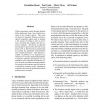Free Online Productivity Tools
i2Speak
i2Symbol
i2OCR
iTex2Img
iWeb2Print
iWeb2Shot
i2Type
iPdf2Split
iPdf2Merge
i2Bopomofo
i2Arabic
i2Style
i2Image
i2PDF
iLatex2Rtf
Sci2ools
84
Voted
ACL
2008
2008
Automatic Editing in a Back-End Speech-to-Text System
Written documents created through dictation differ significantly from a true verbatim transcript of the recorded speech. This poses an obstacle in automatic dictation systems as speech recognition output needs to undergo a fair amount of editing in order to turn it into a document that complies with the customary standards. We present an approach that attempts to perform this edit from recognized words to final document automatically by learning the appropriate transformations from example documents. This addresses a number of problems in an integrated way, which have so far been studied independently, in particular automatic punctuation, text segmentation, error correction and disfluency repair. We study two different learning methods, one based on rule induction and one based on a probabilistic sequence model. Quantitative evaluation shows that the probabilistic method performs more accurately.
ACL 2008 | Automatic Dictation Systems | Computational Linguistics | Speech Recognition Output | True Verbatim Transcript |
| Added | 29 Oct 2010 |
| Updated | 29 Oct 2010 |
| Type | Conference |
| Year | 2008 |
| Where | ACL |
| Authors | Maximilian Bisani, Paul Vozila, Olivier Divay, Jeff Adams |
Comments (0)

